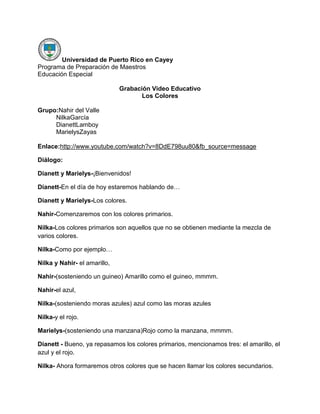Denunciar
Compartir

Recomendados
Recomendados
Más contenido relacionado
Destacado
Destacado (20)
Product Design Trends in 2024 | Teenage Engineerings

Product Design Trends in 2024 | Teenage Engineerings
How Race, Age and Gender Shape Attitudes Towards Mental Health

How Race, Age and Gender Shape Attitudes Towards Mental Health
AI Trends in Creative Operations 2024 by Artwork Flow.pdf

AI Trends in Creative Operations 2024 by Artwork Flow.pdf
Content Methodology: A Best Practices Report (Webinar)

Content Methodology: A Best Practices Report (Webinar)
How to Prepare For a Successful Job Search for 2024

How to Prepare For a Successful Job Search for 2024
Social Media Marketing Trends 2024 // The Global Indie Insights

Social Media Marketing Trends 2024 // The Global Indie Insights
Trends In Paid Search: Navigating The Digital Landscape In 2024

Trends In Paid Search: Navigating The Digital Landscape In 2024
5 Public speaking tips from TED - Visualized summary

5 Public speaking tips from TED - Visualized summary
Google's Just Not That Into You: Understanding Core Updates & Search Intent

Google's Just Not That Into You: Understanding Core Updates & Search Intent
The six step guide to practical project management

The six step guide to practical project management
Beginners Guide to TikTok for Search - Rachel Pearson - We are Tilt __ Bright...

Beginners Guide to TikTok for Search - Rachel Pearson - We are Tilt __ Bright...
Unlocking the Power of ChatGPT and AI in Testing - A Real-World Look, present...

Unlocking the Power of ChatGPT and AI in Testing - A Real-World Look, present...
Guión
- 1. Universidad de Puerto Rico en Cayey Programa de Preparación de Maestros Educación Especial Grabación Video Educativo Los Colores Grupo:Nahir del Valle NilkaGarcía DianettLamboy MarielysZayas Enlace:http://www.youtube.com/watch?v=8DdE798uu80&fb_source=message Diálogo: Dianett y Marielys-¡Bienvenidos! Dianett-En el día de hoy estaremos hablando de… Dianett y Marielys-Los colores. Nahir-Comenzaremos con los colores primarios. Nilka-Los colores primarios son aquellos que no se obtienen mediante la mezcla de varios colores. Nilka-Como por ejemplo… Nilka y Nahir- el amarillo, Nahir-(sosteniendo un guineo) Amarillo como el guineo, mmmm. Nahir-el azul, Nilka-(sosteniendo moras azules) azul como las moras azules Nilka-y el rojo. Marielys-(sosteniendo una manzana)Rojo como la manzana, mmmm. Dianett - Bueno, ya repasamos los colores primarios, mencionamos tres: el amarillo, el azul y el rojo. Nilka- Ahora formaremos otros colores que se hacen llamar los colores secundarios.
- 2. Dianett- Los colores secundarios son el resultado de la unión de los colores primarios. Nahir- Bueno, es hora de comenzar con la actividad de hoy. Marielys- Lo primero son los materiales, vasos, Nahir- agua Marielys- colorante artificial Nahir- y servilletas Marielys- y muy importante, un delantal para no manchar la ropa. Nilka- Bueno teniendo todo listo comencemos. Marielys- Dos envases con agua, primero le echamos azul y lo mezclamos Nilka- y luego le echamos el rojo y lo mezclamos. Pero de esto, en la unión del rojo y el azul, sale el violeta. Repetimos en la unión del rojo y el azul sale el violeta. Dianett-(sosteniendo unas uvas) Violeta como las uvas, mmmm. Nahir- Bueno en la primera parte ya formamos el color violeta. El color violeta es un color secundario. Ya teníamos el color azul. Dianett- Ahora en un envase de agua aplicamos amarillo, lo mezclamos, y en la unión del amarillo y del azul se forma el color verde. Amarillo y azul, forma el verde. El verde es un color secundario. Marielys- (sosteniendo una pera) Verde como la pera, mmmm rico. Nilka- En el segundo paso mezclamos el color verde y como sabemos es un color secundario. Nahir- En el tercer paso vamos a mezclar el color rojo con el color amarillo, para formar el color anaranjado. Repetimos color amarillo y color rojo, color anaranjado. Anaranjado es un color secundario. Dianett- (sosteniendo una naranja) Anaranjado como la naranja, mmmm. Nahir- Luego de haber experimentado, repasamos los colores primarios son el azul, el rojo y el amarillo. Nilka- Cuando mezclamos el azul y el rojo sale el violeta. Dianett- Cuando mezclamos el azul y el amarillo se forma el verde.
- 3. Marielys- Cuando mezclamos el rojo y el amarillo se forma el anaranjado. Nahir- Por tanto, los colores secundarios son el violeta, el verde y el anaranjado.
